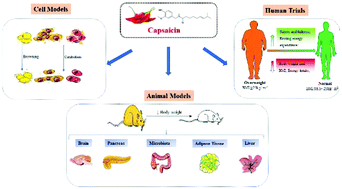Anti-obesity effects of capsaicin and the underlying mechanisms: a review
Abstract
Obesity and overweight have become serious health problems in the world and are linked to a variety of metabolic disorders. Phytochemicals with a weight-loss effect have been widely studied for the past few decades. Capsaicin is the major bioactive component in red chili peppers with many beneficial functions. Its anti-obesity effects have been evaluated extensively using different model systems, including cell models, animal models and human subjects. In this paper, anti-obesity effects of capsaicin are reviewed and the underlying mechanisms are characterized.

- This article is part of the themed collection: Recent Review Articles


 Please wait while we load your content...
Please wait while we load your content...